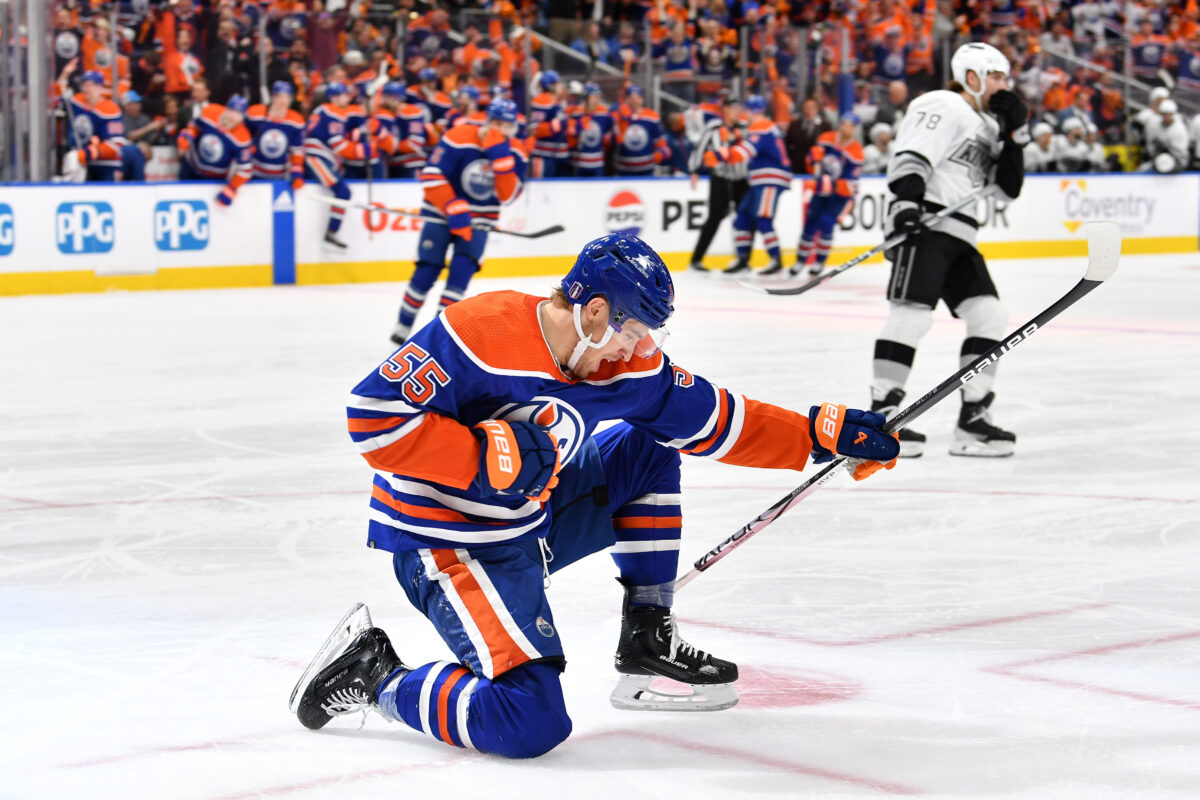St. Louis Blues general manager Doug Armstrong made a massive splash on Tuesday morning, bucking recent NHL tradition and signing two players from the Edmonton Oilers to offer sheets: forward Dylan Holloway, 22, and defenseman Philip Broberg, 23. The Oilers now have seven days to match the offer sheets. If they do not, they are due compensation: a second-round draft pick for Broberg, and a third-round pick for Holloway. In that event, both players would join the Blues next season on two-year contracts.
How Offer Sheets Work
The NHL allows for offer sheets on players who are Restricted Free Agents (RFAs). Any team in the league can sign a player to an offer sheet based. Once signed, the team that owns the player’s rights has one week to “match” the offer sheet, signing him to the identical contract to remain with their organization. If the offer sheet is not matched, then the player changes teams and the team that owns the player’s rights receives compensation based on the size of the contract.
| AAV (in Millions) | Compensation |
| $1.51 or less | None |
| $1.51 to $2.29 | 1 Third Round Pick (Holloway) |
| $2.29 to $4.58 | 1 Second Round Pick (Broberg) |
| $4.58 to $6.87 | 1 First Round Pick + 1 Third Round Pick |
| $6.87 to $9.16 | 1 First Round Pick + 1 Second Round Pick + 1 Third Round Pick |
| $9.16 to $11.45 | 2 First Round Picks + 1 Second Round Pick + 1 Third Round Pick |
| Over $11.45 | 4 First Round Picks |
The Blues have offered both Holloway and Broberg the highest possible AAV in their respective tiers, which is typical for these negotiations (as it theoretically makes the offer sheets harder to match). The Oilers are already above the salary cap with both players still unsigned. Now, newly-installed general manager Stan Bowman has a week to figure out how to shed nearly $7 million in salary cap space if he wants to retain both players’ services.
Offer sheets are often the “third rail” of NHL player movement, with general managers typically refusing to utilize them out of professional courtesy. But Armstrong has used his brilliantly here, targeting two young players who would be huge additions to his core and exploiting a competitive team’s salary cap vulnerabilities. Now, what had been a mostly quiet offseason for the Blues, apart from the Alex Steen succession plan, has suddenly become very interesting, at least for the next week.
Broberg and Holloway Fit Perfectly
As for the players the Blues are attempting to heist, both fit perfectly into the team’s long-term plans. The franchise is in the middle of a rebuild that Armstrong refuses to label a rebuild explicitly. Yet, while the terminology might not be clear, what is clear is that the team wants to add younger talent to build a new core around franchise stars like Robert Thomas and Jordan Kyrou and future up-and-comers like Dalibor Dvorsky and Jimmy Snuggerud. Broberg and Holloway would both fit that mold perfectly.


Both players are in their very early twenties, former high first-round picks, and are thought of as top young players with high ceilings. Broberg, the eighth overall pick in 2019, would immediately become the best young defenseman in the Blues’ system by leaps and bounds and would likely quarterback one of the team’s power play units as early as this season. Holloway, the 14th overall pick in 2020, started to emerge as a threat in the playoffs, where he played all 25 games for the Oilers and scored five goals. It’s likely that both players would see significant playing time on the Blues this season. And in deals reminiscent of the ones Armstrong signed for Jakub Vrana and Kasperi Kapanen recently, the two-year contract length protects the Blues if these risks don’t work out. It’s a calculated gamble and a brilliant one from Armstrong.
Can the Oilers Match?
The focus now turns to Edmonton, where Bowman and company have a week to decide whether they can match these contracts. Already pressed against the salary cap ceiling, their core focus has been on re-signing superstar Leon Draisaitl, whose contract is likely to give him the highest average annual value (AAV) in the league — at least until Connor McDavid signs his extension next summer. The first season of Draisaitl’s new deal will overlap with the second season on both of these offer sheets, making them even harder to match.

By signing two players at once for the same team, Armstrong has given his former divisional rival Bowman an incredibly difficult puzzle to solve. It looks difficult for the Oilers to match on both players. Given that Holloway became a vital part of the team’s forward core during the postseason, the Oilers might be more desperate to keep him. Broberg has not yet fully established himself as part of the core, and played just 10 games in the postseason. Paying him like an established NHL defenseman for two seasons while managing razor-thin cap margins will be tough to do, and if he struggles to find his footing, he could quickly become a public enemy in Alberta. My best guess is that Edmonton matches the offer sheet on Holloway and surrenders Broberg to the Blues.
Armstrong is Still Cooking
For most Blues fans, the biggest benefit of this news will be a renewed faith in the team’s management. In recent seasons, doubt has begun to spread about Armstrong’s continued competency after over a year at the helm. But this move is both brazen and creative, reminiscent of the 59-year-old executive at his best. It will take a week to know whether these moves work out for the Blues, but it’s clear that Armstrong is still willing to get creative in building a better future for his franchise.